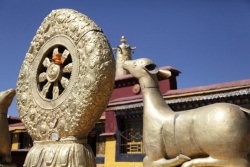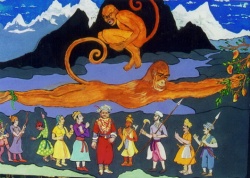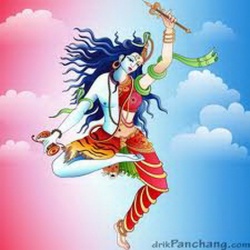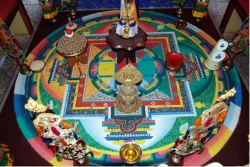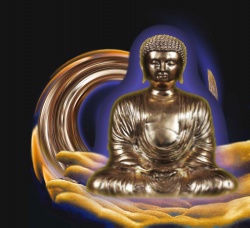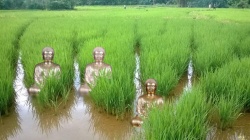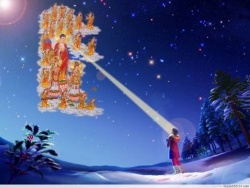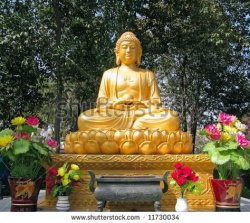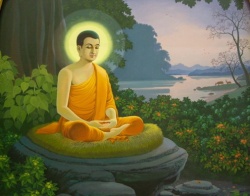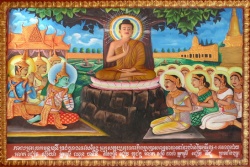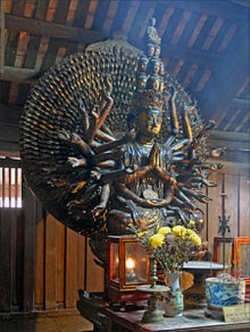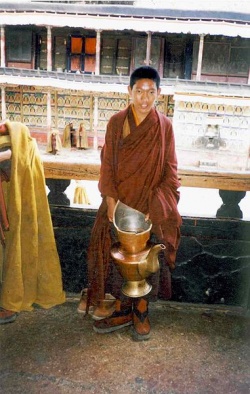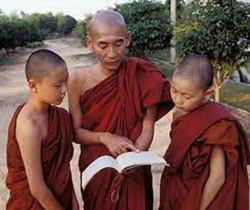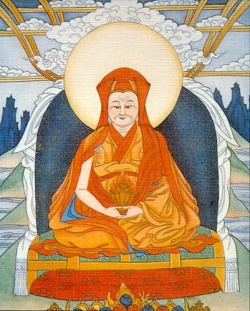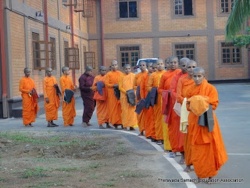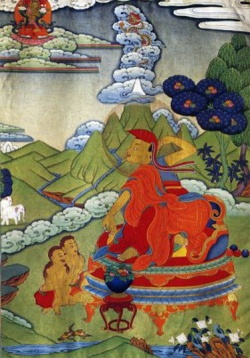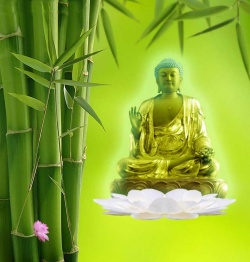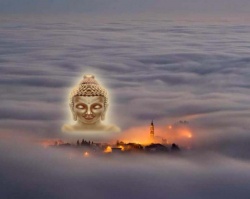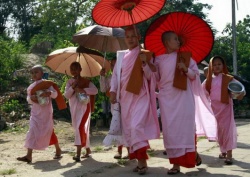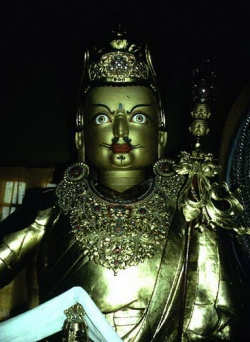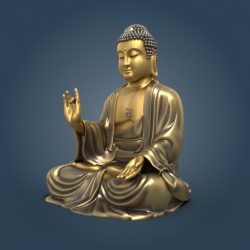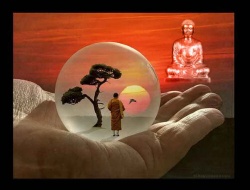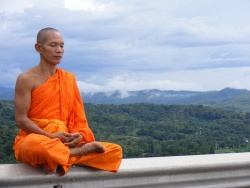Dharmadhatu
Dharmadhatu (chos kyi dbyings).
The 'realm of phenomena;' the suchness in which emptiness and dependent origination are inseparable.
The nature of mind and phenomena which lies beyond arising, dwelling and ceasing. dharmadhatu (fa-jie, cho ying) has several meanings:
1) The content of the mind;
2) all-encompassing space (matrix) in which all phenomena of any sort arise and fall, without beginning or end; or
3) the universe itself with all its world-systems and societies of beings.
It is also used to express absolute reality or the emptiness that is the essence of phenomena.
Dharmadhatu: the realm of all dharmas. The Four Dharmadhatu (Chinese: 四法界), is a philosophical concept propagated by Master Tu-shun (Chinese: 杜順; 557-640 CE).
It builds upon and is a variant of the Dharmadhatu doctrine. Tu-shun is the founder of Hua-yan (Chinese: 華嚴) school. The Four Dharmadhatu were outlined in Tu-shun's treatise which has been rendered into English as 'On the Meditation of Dharmadhātu'. The Four Dharmadhatu are:
The Dharmadhātu of Shih' (Chinese: 事法界; "shi fajie"). 'Shih' is a rendering of the character 事 which holds the semantic field: "matter", "phenomenon", "event". It may be understood as the 'realm' (Sanskrit: dhātu) of all matters and phenomena.
The Dharmadhātu of Li' (Chinese: 理法界; "li fajie"). 'Li' is a rendering of the character 理 which holds the semantic field: "principle", "law", "noumenon". This 'realm' (Sanskrit: dhātu) may be understood as that of principles. It has been referred to as "the realm of the one principle". The "one principle" being qualified as śūnyatā (Sanskrit).
The Dharmadhātu of Non-obstruction of Li against Shih' (Chinese: 理事無礙法界; "lishi wuai fajie"). This 'realm' (Sanskrit: dhātu) has been rendered into English as "the realm of non-obstruction between principle and phenomena".
The Dharmadhātu of the Non-obstruction of Shih and Shih' (Chinese: 事事無礙法界; "shishi wuai fajie"). This 'realm' (Sanskrit: dhātu) has been rendered into English as "the realm of non-obstruction between phenomena".
the Dharmadhatu kind of explain how selflessness of phenomena work in 4 different levels. the final level is the most difficult to understand. 事事无碍. those who reached this level do not judge between good or bad. to them good is good. bad is also good. this is the realm of non-obstruction between All phenomena.
Dharmadhatu (Sanskrit) is the 'dimension', 'realm' or 'sphere' (dhatu) of Dharma and denotes the collective 'one-taste' (Sanskrit: ekarasa) dimension of Dharmata.
==Nomenclature, orthography and etymology==
In Mahayana Buddhism, dharmadhātu (Standard Tibetan: chos kyi dbyings; Chinese: 法界) means "realm of phenomena", "realm of Truth", and of the noumenon.
In this realm, Tathata (Reality "as-it-is"), emptiness, dependent co-arising and the unconditioned, uncreated, perfect and eternal Buddha are one.
It is "not only the extent or expanse of Infinity but also its deepest nature, or essence".
Dharmadhātu is the purified mind in its natural state, free of obscurations.
It is the essence-quality or nature of mind, the fundamental groun of consciousness of the trikaya, which is accessed via the mindstream.
When the buddha-nature has been realised, dharmadhātu is also referred to as the Dharmakāya, the Body of Dharma Truth.
It is one of the Five Wisdoms:
- Dharmadhātu wisdom,
- Mirror-like wisdom,
- Equality wisdom,
- Discriminating wisdom,
- All-accomplishing wisdom.
- It is associated with Vairocana.
==Historical origin==
Kang-nam Oh traces the origin of dharmadhatu to the Avatamsaka Sutra. It has been further developed by the Hua-yen school:
This idea of dharmadhātu-pratītyasamutpāda which was originally found in the Avataṁsaka-sūtra or Hua-yen ching,[a] was fully developed by the Hua-yen school into a systematic doctrine palatable to the Chinese intellectual taste.
The dharmadhātu doctrine[b] can be said to have been, by and large, set forth by Tu-shun (557~640 C.E.), formulated by Chih-yen (602~668), systematized by Fa-tsang (643~712), and elucidated by Ch’eng-kuan (ca. 737~838) and Tsung-mi (780~841).
Understanding in Buddhist tradition
Indian Buddhism
Śrīmālādevī Sūtra
The Śrīmālādevī Sūtra (2rd century CE ), also named The Lion's Roar of Queen Srimala, centers on the teaching of the tathagatagarbha as "ultimate soteriological principle". Regarding the tathagata-garbha it states:
- Lord, the Tathagatagarbha is neither self nor sentient being, nor soul, nor personality.
The Tathagatagarbha is not the domain of beings who fall into the belief in a real personality, who adhere to wayward views, whose thoughts are distracted by voidness.
Lord, this Tathagatagarbha is the embryo of the Illustrious Dharmadhatu, the embryo of the Dharmakaya, the embryo of the supramundane dharma, the embryo of the intrinsically pure dharma.
In the Śrīmālādevī Sūtra, there are two possible states for the Tathagatagarbha:
- [E]ither covered by defilements, when it is called only "embryo of the Tathagata"; or free from defilements, when the "embryo of the Tathagata" is no more the "embryo" (potentiality) but the Tathāgata (=the Dharmakaya)(actuality).
The sutra itself states it this way:
- This Dharmakaya of the Tathagata when not free from the store of defilement is referred to as the Tathagatagarbha.
Nagarjuna
Nāgārjuna wrote a treatise on the dharmadhatu, In praise of the Dharmadhatu. It is the ground which makes liberation possible:
- The dharmadhatu is the ground
- For buddhahood, nirvana, purity, and permanence. [c]
According to Nāgārjuna, the dharmadhatu is seen when the afflictions are purified:
- As butter, though inherent in the milk,
- Is mixed with it and hence does not appear,
- Just so the dharmadhatu is not seen
- As long as it is mixed together with afflictions.
- And just as the inherent butter essence
- When the milk is purified is no more disguised,
- When afflictions have been completely purified,
- The dharmadhatu will be without any stain at all.
Nāgārjuna defines bodhicitta as the medium through which dharmadhātu is perceived and realised:
- Sentient beings’ essence free of substance
- Is the sphere that is encountered on this plane.
- Seeing this is the royal bodhicitta,
- The dharmakaya free of every flaw.
Those who follow the Bodhisattva-path realize the dharmadhatu, or Dharmakaya:
- Just as the moon when it is new
- Visibly grows larger bit by bit,
- Those who have reached the bhumis
- See the dharmakaya more and more.
Chinese Buddhism
Mahaparinirvana Sutra
In the Mahayana Mahaparinirvana Sutra, the Buddha states of himself that he is the "boundless Dharmadhatu" - the Totality itself.
Yutang Lin
Yutang Lin is a student of Buddhist Yogi C. M. Chen, who established Adi Buddha Mandala, following seven "Tantric schools".
Yutang Lin qualifies the dharma in dharmadhātu, it:
- Rrefes to spiritual states that transcend senses and consciousness, and are unspeakable or unimaginable. Under this meaning of "dharma" all dharmas are mutually dependent causes and conditions of their coexistence. Whatever the ordinary worldly view may be, in this sense of "dharma,"
all dharmas are equal as one of the dharmas and this equality transcends considerations of their differences in being real/unreal, superior/inferior, or abundant/deficient.
In this sense of "dharma" the word "Dharmadhatu," literally "realm of dharmas," refers to the collection of all dharmas (Ch: fa chieh, fa jie). "Attaining Buddhahood" or "Attaining Dhammakaya" means having transcended all and any limitations that are due to artificial concepts, subconscious activities, desires and feelings, will and attachment, time and space, etc., and having regained the original state of Dharmadhatu in harmonious oneness.
Yutang Lin affirms the nonlinear, holistic essence-quality of dharmadhātu, unbounded by space and time:
- According to the correct view of Dharmadhatu all dharmas in the past, all dharmas at present and all dharmas in the future are all together in the Dharmadhatu.
Dharmadhatu is neither limited by space nor by time.
Tibetan Buddhism
Dzogchen
In Dzogchen text Gold refined from ore the term Dharmadhatu is translated as 'total field of events and meanings' or 'field of all events and meanings.'
Such translation seems to be paralleling a modern Western philosophical approach to Philosophy of time: Eternalism.
Dharmadhatu (chos kyi dbyings) - The 'realm of phenomena'; the suchness in which emptiness and dependent origination are inseparable.
The nature of mind and phenomena which lies beyond arising, dwelling and ceasing.
In his Buddha Nature, Thrangu Rinpoche said: "In this context, the word for space is ying (dbyings). It is the same word used in dharmadhatu, the realm or 'space' of things.
The word space is used because the dharmadhatu is like the body or realm of empty space where different things, like clouds, birds, and airplanes can fly around without obstruction.
This is because the nature of space is empty and nonexistent. Due to this quality of openness, things can occur.
Likewise, dharmadhatu is the essence of things — empty and in-concrete where all phenomena such as trees, houses, mountains, oneself, other beings, emotions, wisdom, and all experiences can occur openly." [RY]
kun tu bzang po - all-positive/ positive in every way/ wholly positive; Samantabhadra; isc. "the wholly positive" [RB]
kun tu bzang po - Samantabhadra. The 'Ever-excellent One.'
1) The primordial dharmakaya buddha.
2) The bodhisattva Samantabhadra used as the example for the perfection of increasing an offering infinitely [RY]
kun tu bzang mo - Ever-Excellent Lady, Skt. Samantabhadri.
The All-good, the mother of all the buddhas of the three times; the female counterpart / consort of Samantabhadra, the dharmakaya buddha. She symbolizes emptiness and dharmadhatu [RY]
kun gzhi - 1) collecting place, begging bowl;
2) continuum of mind, one's nature;
3) alaya [one of the 8 consciousnesses all-ground, basis/ ground/ fundamental structuring of all experience, the basic store of all consciousness) either samsaric or someties when purified = dharmadhatu. Sometimes aspects of alaya and alayvijnana are distinguished] [IW]
<poem>
klong chen dgongs pa - dharmadhatu [RY]
dgongs pa dbyings su skyol zhig - bring your realization to encompass dharmadhatu! [RY]
rgya khyon dang mnyam pa - as extensive as dharmadhatu [IW]
rgyas gyur rigs - developing gotra i.e. we have gathered accumulations, done practices, cleared away defilements and gradually come to realization. The naturally existing gotra is unconditioned, the dharmadhatu [RY]
cho kyi dbyings - dharmadhatu, expanse of reality [IW]
chos kyi dbying - dharmadhatu, realm of dharmas, element of dharmas [IW]
chos kyi dbyings - dharmadhatu, realm of dharmas [RY]
chos kyi dbyings - Realm of phenomena. 'dharmadhatu.' Dharmadhatu, absolute expanse. expanse of reality [RY]
chos kyi dbyings - Dharma-element, dharmadhatu [IW]
chos kyi dbyings - basic space of phenomenal reality/ dharmadhatu [RY]
chos kyi dbyings - basic space of phenomena; dharmadhatu [RB]
chos kyi dbyings kun tu bzang mo - dharmadhatu Samantabhadri [RY]
chos kyi dbyings kyi zhing khams - the buddhafield of dharmadhatu [RY]
chos kyi dbyings kyi ye shes - dharmadhatu wisdom, wisdom of dharmadhatu, awareness of the expanse of dharma. one of the {ye shes lnga}, five types of pristine awareness; the wisdom of all-encompassing space, dharmadhatu wisdom [RY]
[[chos kyi dbyings kyi ye shes - dharmadh tuj¤ na, dharmadhatu wisdom, wisdom of dharmadhatu [IW]] chos kyi dbyings kyi ye shes - [dharmadhatu-jnana] dharmadhatu wisdom, wisdom of dharmadhatu, awareness of the expanse of dharma. one of the {ye shes lnga}, five types of pristine awareness [RY]
chos kyi dbyings kyi ye shes - wisdom of dharmadhatu [JV]
chos kyi dbyings kyi rang bzhin dbyer med pa bstan pa'i le'u - the chapter which demonstrates the indivisible nature of dharmadhatu [RY]
chos kyi dbyings de kho na'i don - the thatness nature of dharmadhatu [RY]
chos kyi dbyings las nam yang mi g.yo ba - to never depart from dharmadhatu [RY]
chos sku 'od gsal rdo rje snying po'i zhing - Dharmakaya realm of the Luminous Vajra Essence, the realm of the great all-pervasive dharmadhatu [RY]
chos dbyings - Dharmadhatu, ultimate sphere, totality of being, total field of events and meanings, the spher of Dharma, field of all events and meanings, reality field, element of [[[Wikipedia:superior|superior]]] qualities, dharmadhatu, realm of dharmas, {chos khams}; the dimension of all existence; the expanse of All That Is; the sphere of Dharma, expanse of all events, absolute expanse [RY]
chos dbyings - dharmadhatu, reality continuum, the ultimate, the field of knowledge, field of all events and meanings, reality field, field of all experience, total field of events and meanings, ultimate sphere, the absolutely specific characteristics of all the entities of samsara and nirvana, the object by which the empty form is terminated, the continuum that is a pure experience of meaningfulness, SA de bzhin nyid, ultimate sphere, sphere of reality, ultimate dimension of phenomena, fundamental nature of existence, true condition of phenomena, dimension of existence, dimension of emptiness of primordial being [JV]
chos dbyings - basic space of phenomena; dharmadhatu [RB]
chos dbyings - 1) emptiness; 2) nature of emptiness of the five skandhas, dharmadhatu, [IW]
chos dbyings kyi ye shes - The pristine cognition of the expanse of reality, dharmadhatu wisdom one of the five wisdoms)/ ye shes lnga stong nyid rtogs pa'i ye shes [IW]
chos dbyings kyi ye shes - dharmadhatu wisdom, pristine cognition of the expanse of reality [RY]
chos dbyings kyi rang bzhin - the innate nature of the all-embracing expanse of reality/ dharmadhatu, the phenomenal nature of dharmadhatu [IW]
chos dbyings klong - the expanse of dharmadhatu [RY]
chos dbyings sgro 'dogs so gnyis dang bral ba - dharmadhatu free from the natures of either glorification or denigration [IW]
chos dbyings ngo bo ro gcig pa - same taste [in being] dharmadhatu [RY]
chos dbyings stong pa nyid kyi gnas lugs - field of events and meanings {chos dbyings lhun gyis grub pa'i pho brang}, - the spontaneously present palace of dharmadhatu [RY]
chos dbyings bstod pa - Nagarjuna's Dharmadhatu-stotra, praise of dharmadhatu [RY]
chos dbyings 'dus ma byas - Unconditioned dharmadhatu [RY]
chos dbyings spros bral rig pa'i gzhal yas khang - the celestial palace of dharmadhatu awareness, free from conceptions, the dharmadhatu palace unfabricated awareness [RY]
chos dbyings spros bral rig pa'i gzhal yas khang - the celestial palace of dharmadhatu awareness, free from conceptions; the dharmadhatu palace unfabricated awareness, dharmadhatu, the palace of the simplicity of insight [IW]
chos dbyings blo bur bral dag - dharmadhatu which has the purity of being free from temporary defilement [RY]
chos dbyings blo bur bral dag - the purity of dharmadhatu, free of the incidental [IW]
chos dbyings 'od gsal stong pa - an all-encompassing void with luminous clarity, the luminous emptiness of dharmadhatu [IW]
chos dbyings yum gyi klong - the sphere of the dharmadhatu mother [RY]
chos dbyings ye shes - dharmadhatu wisdom, wisdom of dharmadhatu; dharmadhatu pristine awareness; awareness of the expanse of dharma. pristine cognition of the expanse of reality. one of the {ye shes lnga} [RY]
chos dbyings ye shes - dharmadhatu wisdom [IW]
chos dbyings ye shes - omnipresent awareness, reality-field's awareness, primal awareness of the dimension of reality, wisdom of dharmadhatu [JV]
chos dbyings ye shes lnga - the five aspects of the dharmadhatu wisdom [RY]
chos dbyings rang bzhin gyis dag pa - dharmadhatu which is naturally pure [RY]
chos dbyings rang bzhin gyis dag pa - the natural purity of dharmadhatu [IW]
chos dbyings las mi g.yo ba - unmoved from dharmadhatu [RY]
chos dbyings su bsdus pa - subsumed within dharmadhatu [RY]
chos dbyings su ro gcig pa - one taste as dharmadhatu [RY]
chos dbyings lhun gyis grub pa'i pho brang, - the spontaneously present palace of dharmadhatu, the self-existing palace of dharmadhatu [IW]
chos sbyings ye shes - dharmadhatu wisdom [IW]
'jig rten ma mo - Mundane Mother Deities. One of the Eight Sadhana Teachings.
Female divinities manifested out of dharmadhatu but appearing in ways which correspond to mundane appearances through the interrelationship between the mundane world and the channels, winds, and essences within our body.
These have both an ultimate and relative aspect.
The chief figure in this mandala is Chemchok Heruka, the wrathful form of Buddha Samantabhadra in the form known as Ngöndzok Gyalpo, the King of True Perfection. See {ma mo} [RY]
stong pa nyid kyi ye shes - Wisdom of emptiness is the dharmadhatu wisdom [RY]
dam ye - Samaya beings and wisdom beings, {dam tshig pa dang ye shes pa}. The deity visualized by oneself and the innate deity abiding in dharmadhatu [RY]
de kho na nyid - the real, suchness, the way things are, emptiness, thusness, the natural state, dharmata, dharmadhatu, That, that very same, thatness, reality, reality, what actually is, the real thing (it does not always mean the absolute truth, it can also be relative. There is conventional suchness and absolute suchness it can be abbreviated by {de nyid} [IW]
de bzhin nyid - suchness {stong pa nyid/ marklessness, extreme of truth'/ ultimate truth/ dharmadhatu/ emptiness, the markless, complete reality, the absolute, dharmadhatu just as it is, reality, "thusness", as it is (as 1 of the four non- compounds) tathata; the simplicity of dharmadhatu [IW]
de bzhin nyid du ro gcig pa - of one taste with dharmadhatu [IW]
de bzhin nyid bdag - dharmadhatu, the true/holy nature, nature/ lord of suchness [IW]
de bzhin nyid dmigs bsam gtan - meditation on suchness [from bhumi 1 to 10 bodhisattvas dharmadhatu empty meaning in every bhumi meditating with ye shes kyi khyad par gyis rim par] [IW]
don dam chos kyi dbyings - ultimate dharmadhatu [RY]
don dam chos dbyings - the ultimate dharmadhatu [RY]
spros pa mtha' dag chos dbyings su nub pa - the subsiding of all constructed limitations into dharmadhatu [RY]
dbyings - 1) middle of, mid- *, nang;
2) nature, source, dharmadhatu, khams;
3) dignified/ graceful/ awesome rang nyid dbyings che drags pas rjes lus thebs pa;
4) tha mag gi dbyings broken;
5) SK: interest, liking very much lang shor ba [stubborn/ indulgent];
6) expanse, realm, sphere, [basic] space, the heavens, celestial region;
7) totality/ reality field, continuum, expanse, klong [IW]
dbyings - space, dimension, dhatu; space, dharmadhatu. Syn {bde gshegs snying po}; basic space; expanse, space, realm, sphere, basic space, the heavens, celestial region, totality field, dhatu, continuum, reality field, expanse [RY]
dbyings don dam pa'i bden pa - ultimate truth of the nature; ultimate truth of dharmadhatu [RY]
ma mo - Mamo. Abbreviation of 'Mundane Mother Deities' ('jig rten ma mo). One of the Eight Sadhana Teachings. Female divinities manifested out of dharmadhatu but appearing in ways that correspond to mundane appearances through the interrelationship between the mundane world and the channels, winds, and essences within our body.
They have both an ultimate and relative aspect. The chief figure in this mandala is Chemchok Heruka, the wrathful form of Buddha Samantabhadra in the form known as Ngöndzok Gyalpo, the King of True Perfection. 2) A class of semi-divine beings who sometimes act as protectors of the Dharma [RY]
mi 'gul ba gsum - three unmoving states, 3-fold motionlessness [1st of the four consolidations according to all surpassing realisation/{thod rgal} as explained in the {khrid yig ye shes bla ma} 1 without moving from the postures of the body, the energy channels and pranas/winds are relaxed of their own accord {lus bzhag stang las mi 'gul bas rtsa rlung rang dal} two without moving from the gazes of the eyes, appearances are enhanced {mig gzigs stangs las mi 'gul bas snang ba'i 'phel 'dzin} three without moving from the state of the unfabricating mind, the expanse/the space of dharmadhatu and awareness are integrated {sems bzo med la mi 'gul bas dbyings rigs zung du chud par byed} (gd-mk) [IW]
'tshengs pa sum ldan - The three satisfactions are: the negative being's mind is liberated in the dharmadhatu, the dharmapalas receive the flesh and blood of the deceased being transformed into wisdom nectar, and the yogi's life force increases. [RY]
'og min - Akanishtha. The 'highest;' the realm of Vajradhara, the enlightened sphere the dharmakaya buddha. Often used as a synonym for 'dharmadhatu.' [RY]
'og min chos kyi dbyings kyi pho brang - the dharmadhatu palace of Akanishtha. the unexcelled realm [RY]
yang dag pa'i mtha' - suchness/ emptiness/ dharmadhatu, the true goal, the essence of reality [IW]
ye shes - wisdom, original wakefulness. Basic cognizance independent of intellectual constructs. There are also the five wisdoms, aspects of how the cognitive quality of buddha nature functions: the dharmadhatu wisdom, mirror-like wisdom, wisdom of equality, discriminating wisdom and all-accomplishing wisdom [RY]
ye shes lnga - Five wisdoms. The dharmadhatu wisdom, mirror-like wisdom, wisdom of equality, discriminating wisdom and all-accomplishing wisdom [RY]
ye shes lnga - the five wisdoms. {me long, lta bu} mirror [like] wisdom, {mnyam nyid} equality wisdom, {so sor rtog pa} discriminating wisdom, {bya grub} accomplishing wisdom, {chos dbyings} expanse of qualities wisdom, five aspects of pristine awareness; Five Kinds of Pristine Cognition. Five wisdoms.
The pristine cognition of the expanse of reality {chos dbyings kyi ye shes} or dharmadhatu jñana. the mirror-like pristine cognition {me long gi ye shes} or adarsha jnana.
the pristine cognition of discernment {sor rtog pa'i ye shes} or pratyavekshana jnana. the pristine cognition of sameness {mnyam nyid kyi ye shes} or samata jnana. and the pristine cognition of accomplishment {bya ba'i ye shes} or k.rtyanusthana jnana. five types of fruition awareness, the five wisdoms.
1) {chos dbyings} or {chos kyi dbyings kyi ye shes}.
2) {me long} or {me long lta ba'i ye shes}
3) {mnyam nyid} or {mnyam pa nyid kyi ye shes}
4) {sor rtog} or {so sor rtog pa'i ye shes}
5) {bya grub} or {bya ba grub pa'i ye shes} [RY]
ye shes sems dpa' - jnanasattva, wisdom being. (ye shes pa). The real deity abiding in dharmadhatu. pristine awareness aspect of a deity [RY]
gsang ba yum gyi za ma tog - the womb of the secret consort [sm. dharmadhatu [RY]
Source
